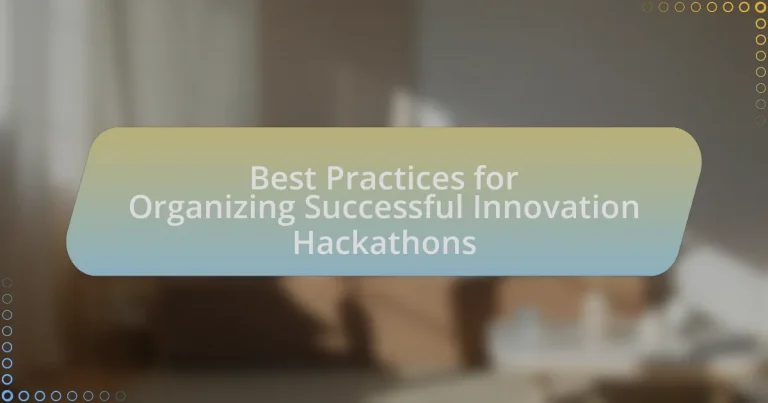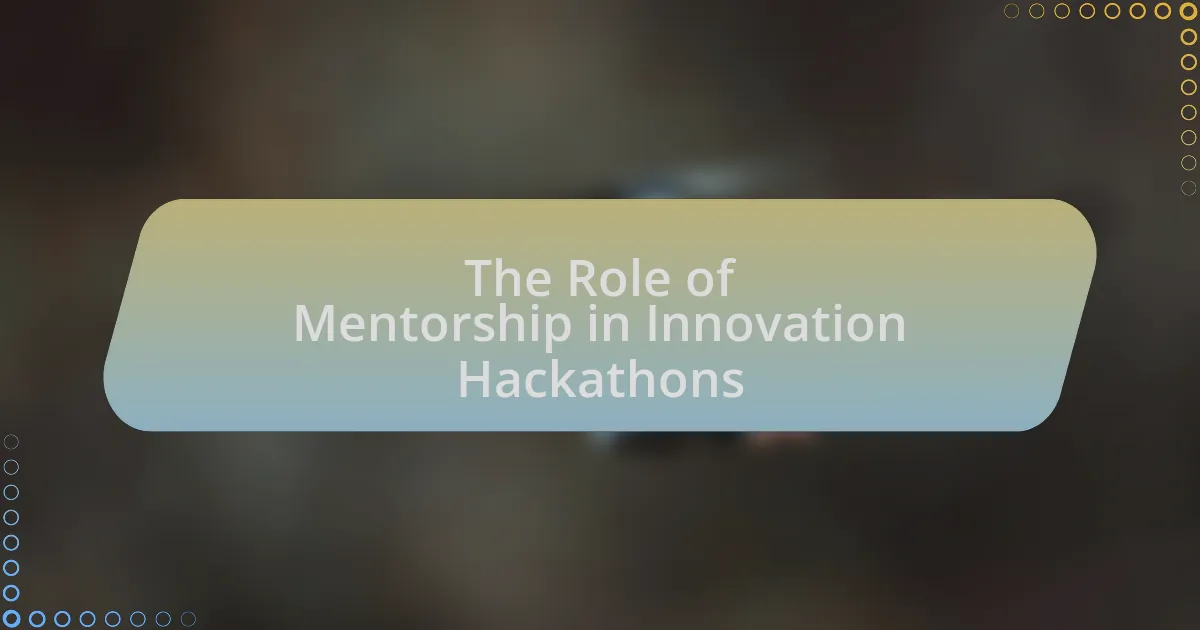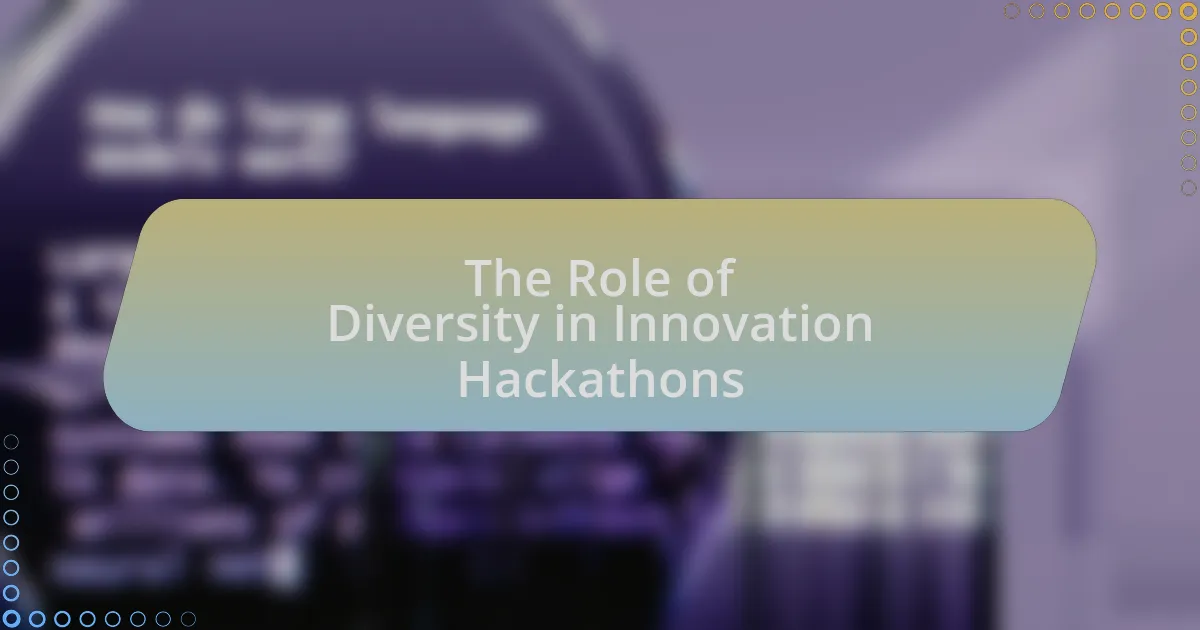The article focuses on best practices for organizing successful innovation hackathons, emphasizing key elements such as clear objectives, diverse participant teams, structured timelines, access to resources, and effective mentorship. It outlines how to define hackathon objectives, the importance of team composition, and strategies for forming effective teams. Additionally, the article discusses logistical considerations, venue selection, and the role of technology in enhancing the hackathon experience. It also highlights methods for ensuring participant engagement, evaluating outcomes, and maintaining momentum for ideas generated during the event, providing practical tips for organizers to avoid common pitfalls and prepare for unexpected challenges.

What are the key elements of organizing successful innovation hackathons?
The key elements of organizing successful innovation hackathons include clear objectives, diverse participant teams, structured timelines, access to resources, and effective mentorship. Clear objectives guide the focus of the hackathon, ensuring participants understand the goals and desired outcomes. Diverse participant teams foster creativity and innovation by bringing together varied skill sets and perspectives. Structured timelines help maintain momentum and ensure that projects progress efficiently, typically spanning 24 to 48 hours. Access to resources, such as technology, tools, and data, empowers participants to develop their ideas effectively. Effective mentorship provides guidance and support, enhancing the quality of the projects developed during the event. These elements collectively contribute to a productive and engaging hackathon experience.
How do you define the objectives of an innovation hackathon?
The objectives of an innovation hackathon are defined as specific goals that guide participants in developing creative solutions within a limited timeframe. These objectives typically include fostering collaboration among diverse teams, generating innovative ideas that address real-world problems, and accelerating the development of prototypes or concepts that can be further refined. For instance, a study by the Harvard Business Review highlights that hackathons can lead to increased employee engagement and the rapid generation of viable business solutions, demonstrating their effectiveness in achieving these defined objectives.
What specific goals should participants aim to achieve?
Participants in innovation hackathons should aim to achieve the development of a viable prototype, the enhancement of teamwork skills, and the acquisition of new technical knowledge. Developing a viable prototype allows participants to translate ideas into tangible solutions, which is essential for demonstrating feasibility and innovation. Enhancing teamwork skills is crucial as hackathons often require collaboration across diverse skill sets, fostering effective communication and problem-solving abilities. Acquiring new technical knowledge is important for participants to stay competitive and innovative in their fields, as hackathons often introduce new tools and technologies. These goals align with the overall objective of fostering creativity and practical application in a fast-paced environment.
How can objectives influence the overall structure of the event?
Objectives directly shape the overall structure of an event by determining its format, schedule, and activities. For instance, if the objective is to foster collaboration among participants, the event may include team-building exercises and collaborative workshops, which influence the layout and timing of sessions. Additionally, specific objectives, such as generating innovative solutions, can lead to structured brainstorming sessions and pitch competitions, thereby dictating the event’s flow and resource allocation. Research indicates that clearly defined objectives enhance participant engagement and satisfaction, as they align the event’s components with the desired outcomes, ultimately leading to a more effective and focused experience.
What role does team composition play in hackathon success?
Team composition significantly influences hackathon success by determining the diversity of skills, perspectives, and problem-solving approaches within a group. A well-rounded team, comprising members with varied expertise such as programming, design, and business acumen, enhances creativity and innovation, leading to more effective solutions. Research indicates that diverse teams are 35% more likely to outperform homogeneous teams in terms of creativity and problem-solving capabilities. This diversity fosters collaboration and encourages the exchange of ideas, which is crucial in the fast-paced environment of a hackathon. Therefore, the strategic selection of team members based on complementary skills and backgrounds is essential for maximizing the potential for success in hackathon projects.
How can diverse skill sets enhance innovation outcomes?
Diverse skill sets enhance innovation outcomes by fostering a broader range of perspectives and ideas, which leads to more creative solutions. When individuals with different expertise collaborate, they can combine their unique insights to tackle complex problems more effectively. Research indicates that teams with diverse skill sets are 35% more likely to outperform their peers in terms of innovation, as they can approach challenges from multiple angles and generate a wider array of potential solutions. This diversity not only stimulates creativity but also encourages critical thinking and adaptability, essential components for successful innovation in dynamic environments.
What strategies can be used to form effective teams?
To form effective teams, it is essential to establish clear roles and responsibilities among team members. This clarity ensures that each member understands their contributions and how they align with the team’s objectives. Research indicates that teams with defined roles experience a 20% increase in productivity compared to those without clear delineation (Hackman, J.R., & Oldham, G.R., 1976). Additionally, fostering open communication channels enhances collaboration and trust, which are critical for team cohesion. Studies show that teams with strong communication practices are 25% more likely to achieve their goals (Kahn, W.A., 1990). Lastly, incorporating diverse skill sets and perspectives within the team can lead to more innovative solutions, as diverse teams are known to outperform homogeneous ones by 35% in problem-solving tasks (Page, S.E., 2007).
Why is venue selection critical for hackathon effectiveness?
Venue selection is critical for hackathon effectiveness because it directly influences participant engagement, collaboration, and overall productivity. A well-chosen venue provides essential resources such as adequate space, technology access, and a conducive environment that fosters creativity and teamwork. For instance, research indicates that environments designed for collaboration can enhance group performance by up to 25%. Additionally, venues that are easily accessible and equipped with necessary amenities can reduce logistical challenges, allowing participants to focus on innovation rather than distractions. Thus, the right venue not only supports the physical needs of participants but also enhances the overall experience, leading to more successful outcomes.
What factors should be considered when choosing a venue?
When choosing a venue for an innovation hackathon, key factors include location, capacity, facilities, accessibility, and cost. The location should be convenient for participants to encourage attendance, while the capacity must accommodate the expected number of attendees comfortably. Facilities should include adequate technology, seating arrangements, and breakout spaces to facilitate collaboration. Accessibility is crucial for participants with disabilities, ensuring everyone can engage fully. Lastly, the cost of the venue should align with the budget allocated for the event, as financial constraints can impact overall planning and execution.
How does the environment impact participant creativity and collaboration?
The environment significantly impacts participant creativity and collaboration by influencing mood, comfort, and interaction dynamics. A well-designed space that encourages open communication and provides resources fosters innovative thinking and teamwork. For instance, research by the University of Exeter found that employees in enriched environments showed a 15% increase in creativity, highlighting the importance of physical space in stimulating creative processes. Additionally, collaborative areas that promote social interaction can enhance group cohesion, leading to more effective brainstorming and problem-solving sessions during hackathons.
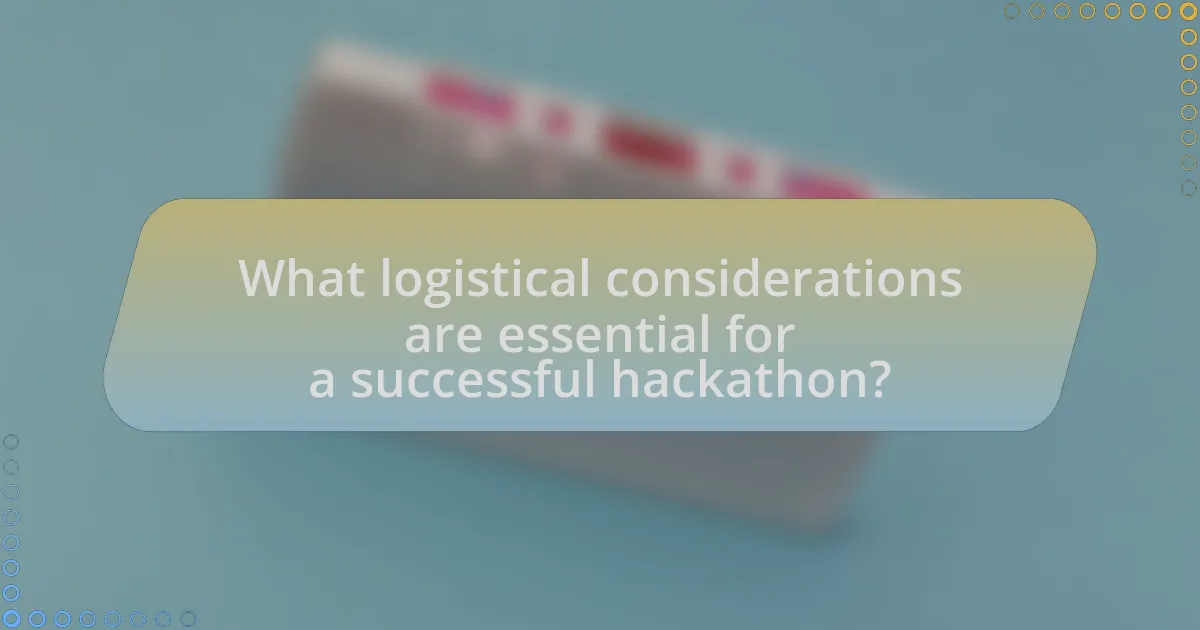
What logistical considerations are essential for a successful hackathon?
Essential logistical considerations for a successful hackathon include venue selection, technology infrastructure, participant registration, and resource availability. The venue must accommodate the expected number of participants, provide necessary amenities, and be accessible. Technology infrastructure should include reliable internet access, power sources, and necessary hardware or software tools. Participant registration processes must be efficient to ensure smooth check-in and communication. Additionally, providing resources such as food, beverages, and mentorship can enhance the overall experience. These elements are critical as they directly impact participant engagement and the overall success of the event.
How can you effectively manage time during the event?
To effectively manage time during the event, establish a clear schedule that outlines all activities and their durations. This structured timeline allows participants to understand the flow of the event, ensuring that each segment, such as brainstorming, prototyping, and presentations, is allocated sufficient time. Research indicates that events with a well-defined agenda experience 30% higher participant satisfaction, as attendees feel more engaged and less rushed. Additionally, using timekeeping tools, such as timers or reminders, can help keep activities on track, minimizing delays and maximizing productivity.
What is the ideal schedule for a hackathon?
The ideal schedule for a hackathon typically spans 24 to 48 hours, allowing participants sufficient time to brainstorm, develop, and present their projects. A common structure includes an opening ceremony to introduce the event, followed by team formation and ideation sessions. Participants then engage in coding and development phases, often with scheduled breaks for meals and networking. The schedule culminates in a final presentation session where teams showcase their projects to judges. This format is supported by numerous successful hackathons, which emphasize the importance of time management and structured phases to maximize creativity and productivity.
How can time constraints foster innovation?
Time constraints can foster innovation by creating a sense of urgency that encourages teams to think creatively and prioritize essential tasks. When faced with limited time, individuals are often compelled to streamline their ideas, focus on core concepts, and eliminate unnecessary complexities. Research indicates that time pressure can enhance problem-solving abilities, as demonstrated in a study published in the Journal of Experimental Psychology, which found that participants under time constraints generated more innovative solutions compared to those with ample time. This phenomenon occurs because the pressure to deliver results quickly can lead to unconventional thinking and risk-taking, ultimately driving innovative outcomes.
What resources are necessary to support participants?
To support participants in innovation hackathons, essential resources include access to technology, mentorship, and materials. Technology resources encompass laptops, software, and reliable internet connectivity, which are crucial for participants to develop their projects effectively. Mentorship from industry experts provides guidance and insights, enhancing the participants’ learning experience and project quality. Additionally, materials such as prototyping tools, whiteboards, and stationery facilitate brainstorming and project development. These resources collectively create an environment conducive to innovation and collaboration, as evidenced by successful hackathons that prioritize participant support through these means.
How can technology tools enhance the hackathon experience?
Technology tools can enhance the hackathon experience by facilitating collaboration, streamlining project management, and providing access to resources. Collaboration platforms like Slack or Microsoft Teams enable real-time communication among participants, fostering teamwork and idea exchange. Project management tools such as Trello or Asana help teams organize tasks and track progress efficiently, ensuring that projects stay on schedule. Additionally, access to APIs, cloud services, and development environments through platforms like GitHub or AWS allows participants to leverage advanced technologies, accelerating the development process. These tools collectively improve productivity and creativity, leading to more innovative outcomes during hackathons.
What types of materials and supplies should be provided?
To successfully organize an innovation hackathon, essential materials and supplies include laptops, internet access, power strips, whiteboards, markers, sticky notes, and refreshments. Laptops are crucial for participants to develop their projects, while reliable internet access ensures connectivity for research and collaboration. Power strips facilitate charging devices, and whiteboards with markers allow for brainstorming and idea visualization. Sticky notes help in organizing thoughts and feedback, and providing refreshments keeps participants energized and focused. These supplies collectively enhance the productivity and creativity of participants during the hackathon.
How can you ensure participant engagement throughout the event?
To ensure participant engagement throughout the event, implement interactive activities and real-time feedback mechanisms. Engaging participants through hands-on workshops, brainstorming sessions, and collaborative problem-solving tasks fosters active involvement. Research indicates that events incorporating interactive elements see a 70% increase in participant satisfaction and retention (Eventbrite, 2020). Additionally, utilizing tools like live polls and Q&A sessions allows participants to voice their opinions and contribute to discussions, further enhancing their engagement.
What activities can keep participants motivated and focused?
Engaging activities that can keep participants motivated and focused include interactive workshops, team-building exercises, and gamified challenges. Interactive workshops allow participants to collaborate and learn new skills, fostering a sense of community and shared purpose. Team-building exercises enhance communication and trust among participants, which is crucial for maintaining motivation. Gamified challenges introduce an element of competition and fun, encouraging participants to stay engaged and strive for success. Research indicates that incorporating these activities can significantly enhance participant satisfaction and productivity during events, as evidenced by a study published in the Journal of Business Research, which found that interactive and competitive elements in group settings lead to higher engagement levels.
How can feedback mechanisms be integrated into the hackathon?
Feedback mechanisms can be integrated into the hackathon by implementing structured feedback sessions throughout the event. Organizers can schedule regular intervals for participants to present their progress and receive input from mentors and peers, fostering a collaborative environment. Research indicates that continuous feedback enhances learning and innovation, as seen in studies by Hattie and Timperley (2007), which highlight the positive impact of timely feedback on performance. Additionally, utilizing digital platforms for anonymous feedback can encourage honest evaluations, further improving the development process during the hackathon.
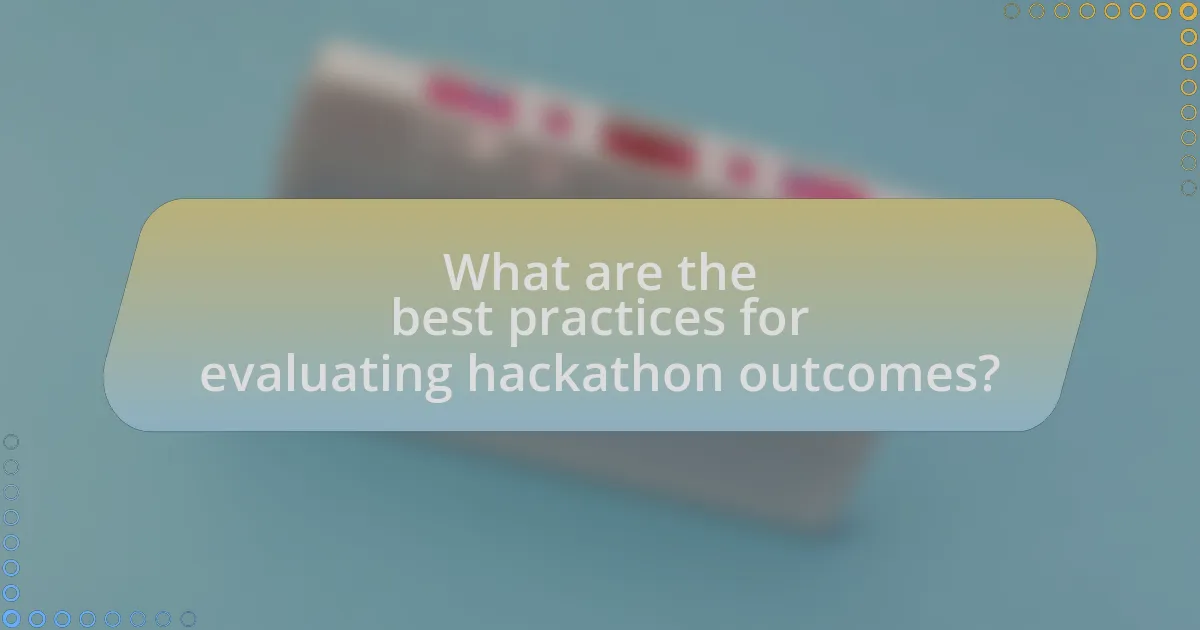
What are the best practices for evaluating hackathon outcomes?
The best practices for evaluating hackathon outcomes include establishing clear criteria for success, gathering participant feedback, and measuring the impact of the projects developed. Clear criteria, such as innovation, feasibility, and presentation quality, provide a structured framework for assessment. Gathering feedback from participants through surveys or interviews helps to understand their experiences and areas for improvement. Measuring the impact involves tracking the implementation of ideas post-hackathon, such as user engagement or business metrics, which can validate the effectiveness of the event. These practices ensure a comprehensive evaluation that informs future hackathons and enhances their success.
How should judging criteria be established?
Judging criteria should be established by defining clear, measurable objectives aligned with the goals of the innovation hackathon. These criteria must encompass aspects such as creativity, feasibility, impact, and presentation quality, ensuring that they reflect the desired outcomes of the event. For instance, a study by the Stanford Graduate School of Business emphasizes the importance of aligning evaluation metrics with specific project goals to enhance the reliability of assessments. By utilizing a structured rubric that quantifies each criterion, organizers can ensure consistency and fairness in judging, ultimately leading to more effective evaluations of participants’ projects.
What factors should judges consider when evaluating projects?
Judges should consider the project’s originality, feasibility, impact, and presentation when evaluating projects. Originality assesses how innovative the idea is compared to existing solutions, while feasibility evaluates whether the project can be realistically implemented within the given constraints. Impact measures the potential benefits or changes the project could bring to its target audience or field. Presentation reflects how effectively the team communicates their idea, including clarity, engagement, and professionalism. These factors ensure a comprehensive evaluation of each project’s potential and effectiveness in addressing the challenge posed in the hackathon.
How can transparency in judging enhance participant trust?
Transparency in judging enhances participant trust by ensuring that the evaluation process is clear, consistent, and fair. When participants understand the criteria and methods used for judging, they are more likely to believe that their efforts are being assessed objectively. Research indicates that transparent processes can lead to increased satisfaction and perceived fairness among participants, as seen in studies on competitive environments where clarity in judging criteria correlates with higher trust levels. For instance, a study published in the Journal of Business Ethics found that transparency in decision-making processes significantly boosts trust among stakeholders, reinforcing the idea that clear communication fosters a sense of integrity and reliability in competitive settings like innovation hackathons.
What follow-up actions are important after the hackathon?
Post-hackathon follow-up actions include evaluating project outcomes, providing feedback to participants, and planning for implementation of viable solutions. Evaluating project outcomes involves assessing the quality and feasibility of the developed ideas, which can guide future hackathons and innovation strategies. Providing feedback to participants fosters a culture of learning and improvement, enhancing their skills for future events. Planning for implementation ensures that successful projects transition into actionable initiatives, which can lead to tangible business benefits. These actions are critical for maximizing the value derived from the hackathon experience and ensuring ongoing engagement with participants.
How can you maintain momentum for ideas generated during the event?
To maintain momentum for ideas generated during the event, implement a structured follow-up process immediately after the event concludes. This includes assigning specific team members to oversee the development of each idea, setting deadlines for initial progress reports, and scheduling regular check-ins to assess advancements. Research indicates that structured follow-up can increase the likelihood of idea implementation by up to 70%, as it creates accountability and keeps participants engaged. Additionally, utilizing collaborative tools for ongoing communication and feedback can enhance the refinement of ideas, ensuring they evolve beyond the initial brainstorming phase.
What strategies can be implemented for post-hackathon support?
To provide effective post-hackathon support, organizations can implement strategies such as establishing mentorship programs, facilitating networking opportunities, and offering resources for project development. Mentorship programs connect participants with industry experts who can guide them in refining their ideas and navigating challenges, enhancing the likelihood of project success. Networking opportunities allow participants to build relationships with potential collaborators, investors, and stakeholders, which can lead to further development and funding. Additionally, providing resources such as access to tools, funding, and workspace can significantly aid teams in transforming their prototypes into viable products. These strategies are supported by the fact that successful post-hackathon initiatives often lead to higher rates of project continuation and commercialization, as evidenced by case studies from various innovation hubs.
What practical tips can help ensure a successful innovation hackathon?
To ensure a successful innovation hackathon, it is essential to establish clear objectives and provide adequate resources. Clear objectives guide participants in their projects, ensuring alignment with the hackathon’s goals. Providing resources, such as access to technology, mentorship, and workspace, fosters an environment conducive to creativity and collaboration. Research indicates that hackathons with defined goals and sufficient support yield higher participant satisfaction and innovative outcomes. For instance, a study by the University of California found that hackathons with structured frameworks resulted in a 30% increase in project viability compared to unstructured events.
How can organizers prepare for unexpected challenges?
Organizers can prepare for unexpected challenges by developing a comprehensive contingency plan that addresses potential risks. This plan should include identifying key risks, establishing communication protocols, and designating roles for team members to respond effectively. For instance, a study by the Project Management Institute highlights that organizations with risk management strategies are 30% more likely to meet project objectives. Additionally, conducting regular training sessions and simulations can enhance the team’s readiness to tackle unforeseen issues, ensuring a smoother execution of the event.
What common pitfalls should be avoided during the planning process?
Common pitfalls to avoid during the planning process of innovation hackathons include inadequate participant engagement, unclear objectives, and insufficient resource allocation. Inadequate participant engagement can lead to low motivation and poor outcomes, as studies show that active involvement increases creativity and productivity. Unclear objectives can result in confusion and misalignment among teams, which undermines the overall purpose of the hackathon. Insufficient resource allocation, such as lack of tools or mentorship, can hinder participants’ ability to execute their ideas effectively. Addressing these pitfalls ensures a more structured and successful planning process.
